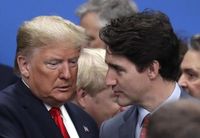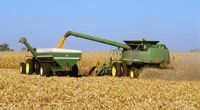President Donald Trump’s recent tariff threats have put American crop farmers in a precarious position, as the agricultural sector braces for increased costs and potential market fluctuations. On March 4, 2025, Trump announced a significant 25% tariff on imports from Canada and Mexico while raising tariffs on certain goods from China up to 20%. Just two days later, on March 6, he suspended the tariffs on products compliant with the United States-Mexico-Canada Agreement (USMCA) until April 2 and lowered the levy on non-USMCA-compliant potash to 10%. This fertilizer, crucial for boosting crop yields, sees approximately 80% of its imports sourced from Canada, which is known to produce more potash than any other country globally.
In addition to the immediate threats posed by these tariffs, agricultural experts are expressing their concerns regarding the long-term viability of U.S. farming operations. Increasing tariffs on vital farming products like potash have raised alarms about farmers struggling to maintain profitability. Many fear that these financial strains may cause further consumer cost increases, in a scenario where demand for crops outpaces supply. A McKinsey & Company survey conducted in 2022 revealed that, alarmingly, 80% of U.S. farmers listed rising input costs—including fertilizers, labor, and crop protection—as their top risk to profitability.
American Farm Bureau Federation President Zippy Duvall has voiced concerns about the pressures facing farmers in the wake of Trump's proposed tariffs. “Adding even more costs and reducing markets for American agricultural goods could create an economic burden some farmers may not be able to bear,” Duvall stated. These burdens are compounded by other policy decisions that have arisen under the Trump administration, including a freeze on U.S. Department of Agriculture funding for grants and loans, leaving several agricultural projects stalled or struggling to secure necessary financial resources.
Meanwhile, dairy farmers in the U.S. are also feeling the heat as trade talks between the U.S. and Canada continue. Senators from several U.S. dairy states, including Tammy Baldwin (D-WI) and Roger Marshall (R-KS), have petitioned the Trump administration for assistance in leveling the playing field. They have highlighted Canada’s failure to adhere to the commitments made under USMCA, which was designed to ensure fair access to dairy markets. In a recent letter sent to the White House, the senators stated, “Canada hasn’t lived up to its agreements for years.”
The dynamic unfolding in the dairy industry is integral to understanding the complexities of Trump's tariff policies. Canada imposes significant tariffs on U.S. dairy products—up to 298% on certain items like butter, as Trump himself pointed out in a post on Truth Social. He accused Canada of cheating U.S. farmers by retaining these high tariffs on dairy imports, while American producers struggle to benefit from the same markets.
Trump's inconsistent tariff strategies have spurred further retaliatory measures and mutterings of concern across North America. Economists argue that the Trump administration is motivated not just by domestic economic interests but also by a drive to impede the ascendance of rival economic powers, particularly China. The chaotic tariff policies are raising questions about their long-term viability and the potential for a cohesive international trade framework.
As the overall impact of Trump’s tariffs becomes clearer, the geopolitical ramifications cannot be overlooked. Observers note that many major trading partners are now united in opposition to the U.S. approaches, creating fractures in previously stable trade relations. In view of the interconnectedness of global economies, the recent shifts could result in a dangerous 'race to the bottom,' where countries have little incentive to cooperate. The ongoing tensions raise the specter of an intensive multilateral trade agreement reset.
Mark Carney, among other Canadian political figures, has voiced concerns about the ramifications of lowered trade cooperation and increased tariff barriers. In his remarks following his leadership selection within the Liberal Party of Canada, he pointed out, “The swinging pendulum of the president’s off-again, on-again threats has also stirred confusion.” Analysts stress the urgency for both Canada and the U.S. in pursuing stabilizing conversations, potentially leading to a renegotiation of the USMCA.
The new terms of any revised agreement could largely revolve around the autonomous nature of agricultural products and tariffs on those imports, as Canada’s ongoing limitations become a focal point for future discussions. Should the current tensions persist, both American and Canadian farmers could continue to face significant losses, which, according to Carney, may just be exacerbated by further turmoil in U.S. policy approaches.
Ultimately, whether through cooperative negotiations or retaliatory measures, the long-term implications of the Trump administration's tariff endeavors will require careful navigation. With agricultural foundations at stake, both nations must recognize the stakes involved in ensuring a stable food supply for their populations.








